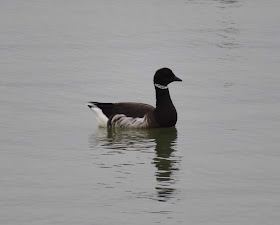The black brant was feeding close to the path behind the Dabchicks sailing club in West Mersea on a dull Monday 25th. Pictured here at back left with a family of dark-bellied brent geese showing two adults with four young.
Even in the dull and grey conditions the black brant features of broad white collar and the blacker back contrasting with the white flanks, stand out from the brent geese.
A ringtail hen harrier was watched flying over the Strood fields on Monday, hunting along the borrowdyke, then scattering the wader roost on the saltmarsh near the Strood causeway before crossing over the road at about midday and heading north-east to the Pyefleet. This is presumably the same bird seen the previous day at the west end of the Pyefleet which spent ten minutes resting on the saltmarsh near Langenhoe Creek before heading towards the Island near the Strood. This is the first hen harrier seen on the Island this year.
Also on Monday along the Strood channel was a marsh harrier on Ray Island, common buzzard, two sparrowhawks and a kestrel. Four rock pipits were by the seawall, 30 carrion crows and a mistle thrush were by Feldy View.
A guillemot was diving for food amongst the boat moorings opposite the West Mersea Hard on Monday.
Along the Bower Hall section of the north side of Mersea Island on Sunday 24th, two marsh harriers, two common buzzards, 2 kestrels, 15 corn buntings, 4 rock pipits, common snipe, 800 knot and three common seals were seen near the top end of the Pyefleet channel. Close-by at Maydays farm, 700 brent geese fed in the fields, 20 red-legged partridges, 3 yellowhammers and a mistle thrush were noted.
At West Mersea on Sunday 24th, Jonathan Norgate saw 2 red-throated divers fly out to sea past the Monkey Beach, while another one later flew over the Hard. A chiffchaff was seen again in the scrub at St Peters.
On Saturday 23rd a Lapland bunting flew east along the Reeveshall seawall calling as it headed towards the Oyster Fishery. Other small birds in the area included 20 corn buntings, 22 goldfinches, 8 linnets, rock pipit, fieldfare and three stonechats. A large flock of 1000 brent geese fed in one field, marsh harrier, buzzard, sparrowhawk and two kestrels were also seen.
In the Pyefleet 4000 knot were feeding on the mud, four little grebes and four great crested grebes were in the channel and a green sandpiper flew out of a ditch. A red squirrel was in a tree alongside Shop Lane near Fishponds Wood.
A black-throated diver swam close to East Mersea Point as it swam upriver into the Colne on Friday 22nd. A peregrine flew over the park's grazing fields scattering all the birds especially the 1000 wigeon, 48, black-tailed godwits, 100 lapwing as well as the 1000 golden plover roosting on the mud. The peregrine dropped down onto the mud and stood there for several minutes surveying the scene.
Also on the fields were 11 greylag geese, 15 goldfinches and a sparrowhawk flew over, while on the saltmarsh two rock pipits were noted.
A handful of lapwings were feeding in the horse paddock by the East Mersea Golfhouse on Friday.
On the northside of Bromans Lane, twenty red-legged partridges were seen in a field.
A song thrush was at the feeder in the Firs Chase garden on Thursday 21st, as was the coal tit and a great spotted woodpecker.
In the fields near Rewsalls Farm on Thursday 21st, there were 25 corn buntings, 25 chaffinches, 20 pied wagtails, 5 fieldfares, 15 blackbirds, 30 skylarks were seen feeding. Two green woodpeckers had a a lucky escape from the clutches of a sparrowhawk while a chiffchaff was calling from a hedgerow.
Ten Mediterranean gulls were feeding with a small flock of black-headed gulls and two kestrels were also hunting over the fields.
A walk along some of the Strood seawall on Wednesday 20th provided views of an avocet, 66 shelduck, 15 knot and a rock pipit while a mistle thrush was near Feldy View.
At Maydays on Wednesday Martin Cock saw the kingfisher, stonechat and 4000 knot.
Offshore from the Monkey Beach at West Mersea on Tuesday 19th, Andy Field saw 2 red-throated divers, great northern diver, eider and three common scoter.








No comments:
Post a Comment